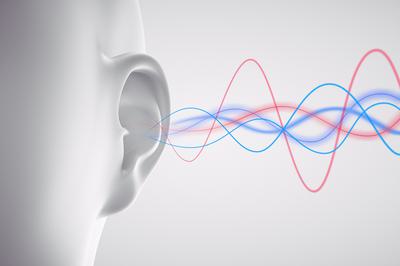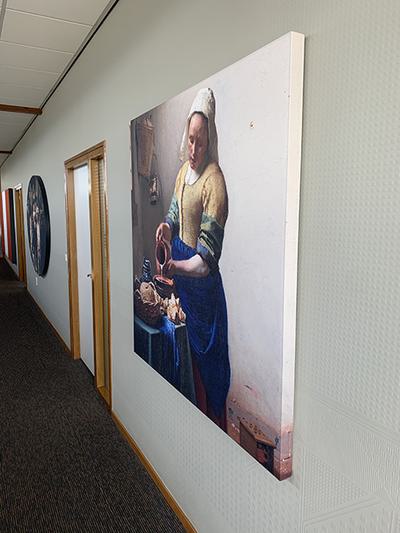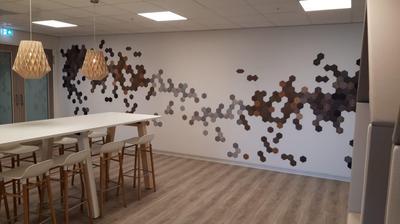Where is sound absorption material best placed?
As we have read before, sound is the vibration of air and travels in waves. These waves bounce off hard surfaces and are picked up by the auricle and are then conducted to the ear inside the head.
When sound reflects annoyingly, it is necessary to install acoustic panels.
Frequently Asked Questions
- Where is the best place to place acoustic panels?
- Where is it pointless to place absorption material in a room?
- What does acoustically open mean?
- Absorption under table or chair; does that work?
- Absorption behind painting or photo panel; does that make sense?
- Acoustic wallpaper; does that improve my acoustics?
Would you like to know how you can improve the acoustics in your room(s)? Then make an appointment for an acoustic measurement.

Diffusion of sound
The reflections from wall surfaces are most emphatically audible if they are straight and hard. Absorption at ear height on the wall, as close as possible to the sound sources, is most effective.
Placing acoustic panels at a height of 120 cm (between 80 cm and 200 cm) is often sufficient. Then it is benefited from both sitting and standing.
In low rooms with large floor areas, the ceiling is suitable. Here too, the closer to the sound sources, the better. So above a table or sitting area.
To increase the attenuation of sound over distance, placing screens between the sound sources is a good choice, if they also block sound in addition to absorption.
Indirect absorption of sound
There is a persistent misunderstanding that it makes sense to place absorption material under tabletops or chairs and behind paintings or photo panels.
"What you don't see, you don't hear". So indirect absorption of sound has a very low efficiency. Save yourself this trouble and the investment.
Acoustically open
To absorb sound, the material must be acoustically open. This means that the material must have pores or openings for the absorption of the sound waves. The energy of the sound can then be converted into heat and so it does not reflect in space. This is the essence of sound absorption.
If the absorption material is “closed”, it cannot absorb the sound waves properly and the sound will continue to reverberate in the room, resulting in a hollow sound, echo and reverberation.

Absorption under the table or chair
When we sit at a table and make noise, it happens above the table. To ensure that sound does not reflect annoyingly and that you suffer as little as possible from this sound, the sound must be absorbed as quickly as possible. This means directly next to the people who make noise or directly above the table, close to the sound source.
After all, the sound waves will reflect off hard surfaces such as the table, the walls, and the ceiling. By the time it reaches the underside of the tabletop, the sound has already had too much of a chance to reflect and bother you too much.
It is better to opt for a nice acoustic wall panel or ceiling panel, or for an acoustic screen between the workplaces.

Absorption behind painting or photo panel
A traditional painting is made on special canvas. This is too tightly woven to remain acoustically open to the acoustics package behind it. In addition, the applied paint reflects the sound even more. The well-known canvas products with a photo print also hardly have an absorbent effect.
Placing sound-absorbing material behind an ordinary painting or photo panel is therefore pointless!
Art lovers should opt for an acoustic painting or photo panel. This is a specially manufactured acoustic panel with a drawing, painting, or other imprint, whereby the canvas remains “open”.
As mentioned, this opening is necessary to allow the sound reflections to penetrate the sound-absorbing material behind the screen.

Acoustic wallpaper
Acoustic wallpaper can contribute to improving the acoustics in a room.
But... it is important to remember that the degree of absorption depends on the thickness and density of the acoustic wallpaper, as well as the frequency of the sound to be absorbed. The absorption value of acoustic wallpaper can vary depending on the specific type of wallpaper and the frequency of the sound to be absorbed.
In general, acoustic wallpapers have an average absorption value of 0.1 to 0.3. The absorption value is measured on a scale of 0 to 1, where 0 means that the material absorbs no sound and 1 means that the material absorbs all sound. An absorption value of 0.1 to 0.3 (note: 0 point…) means that the acoustic wallpaper absorbs part of the sound, but not all sound waves. An acoustic wall or ceiling panel does much more using a smaller surface.
Would you like to know which acoustic solution is the best in your situation? Then we would be happy to provide you with a tailor-made advice.